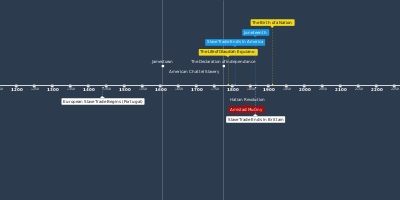7 mars 1965 - Bloody Sunday
Description:
On March 7, 1965, an estimated 525 to 600 civil rights marchers headed southeast out of Selma on U.S. Highway 80. The march was led by John Lewis of SNCC and the Reverend Hosea Williams of SCLC, followed by Bob Mants of SNCC and Albert Turner of SCLC. The protest went according to plan until the marchers crossed the Edmund Pettus Bridge, where they encountered a wall of state troopers and county posse waiting for them on the other side.County Sheriff Jim Clark had issued an order for all white males in Dallas County over the age of twenty-one to report to the courthouse that morning to be deputized. Commanding officer John Cloud told the demonstrators to disband at once and go home. Rev. Hosea Williams tried to speak to the officer, but Cloud curtly informed him there was nothing to discuss. Seconds later, the troopers began shoving the demonstrators, knocking many to the ground and beating them with nightsticks. Another detachment of troopers fired tear gas, and mounted troopers charged the crowd on horseback.
Televised images of the brutal attack presented Americans and international audiences with horrifying images of marchers left bloodied and severely injured, and roused support for the Selma Voting Rights Campaign. Amelia Boynton, who had helped organize the march as well as marching in it, was beaten unconscious. A photograph of her lying on the road of the Edmund Pettus Bridge appeared on the front page of newspapers and news magazines around the world. In all, 17 marchers were hospitalized and 50 treated for lesser injuries; the day soon became known as "Bloody Sunday" within the black community.
After the march, President Johnson issued an immediate statement "deploring the brutality with which a number of Negro citizens of Alabama were treated". He also promised to send a voting rights bill to Congress that week, although it took him until March 15.
SNCC officially joined the Selma campaign, putting aside their qualms about SCLC's tactics in order to rally for "the fundamental right of protest". SNCC members independently organized sit-ins in Washington, DC, the following day, occupying the office of Attorney General Nicholas Katzenbach until they were dragged away.
The Executive Board of the NAACP unanimously passed a resolution the day after "Bloody Sunday", warning:
If Federal troops are not made available to protect the rights of Negroes, then the American people are faced with terrible alternatives. Like the citizens of Nazi-occupied France, Negroes must either submit to the heels of their oppressors or they must organize underground to protect themselves from the oppression of Governor Wallace and his stormtroopers.
Ajouté au bande de temps:
Date:
7 mars 1965
Maintenaint
~ Il y a 60 ans
